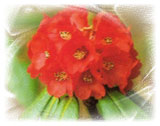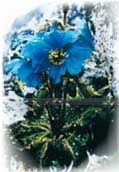Within
less than 900 kilometers length from east to west
and about 200 kilometers width north to south,
formed an extreme, contrasts in climate and geography
of Nepal. The unique topography ranging from lowland
with sub-tropical jungles to arctic conditions
in the Himalayan highlands, beginning from 150m
of see level from south it raises more then 8000m
in the north which results a reality of all climate
zone found on this planet. So the great diversity
of climate provides a huge home for a large variety
of plants, birds and animals. |
Wide
variety of 6500 known species of trees, shrubs,
and wild flowers, even the orchid are found of
300 types found in Nepal. When rhododendrons burst
into color in March and April, the height of floral
glory can be witnessed (which is also a national
flower of Nepal), among 60 species 30 species
only in Nepal. The blossoming of a variety of
shrubs and wild flowers makes the land lavender.
Some flowers are favorite to god like Holy basil
(tulsi) for Bishnu, lotus for Laxmi which is symbol
of purity, representing the pure mind of enlightment
rising from the mud of earthy concerns.
|
 |
The bright
red poinsettias (lalupate) is favorite to all
gods. Most of the forest of Nepal is dominated
by Sal (sherea starobu) trees which grows up to
30 meter in height. We suggest our visitors to
take a deep breath in the shadow of the Pipal
Chautara, Pipal(ficus bengaledsis) and Banyan(ficus
religiosa) trees built by local people as a public
service for visitors. |
|
|
In
Hindu mythology the slaughtering of Cow
is equal to murder a human. In Nepal the
penalty is
Rs. 20,000/- or two years imprisonment.
One-horned rhino which is different to its
African relative two-horned rhino is well
preserved at Chitwan and relocated in Bardia.
Many other species like spotted leopard,
deer, bear, jackal, pica, fox, snakes……etc.
are found in the forest. Among these Royal
Bangal Tiger is on the top of the food chain
which is habitats of Chitwan and Bardia.
Achieving the right
balance between ecological and human needs
is a tricky matter however Nepal is trying
to protect the natural environment. Around
14% of Nepal’s total area is set aside
as National Park and wildlife reserves.
The main aim is to conserve and manage the
country splendid natural heritage. Some
national parks have been declared UNESCO
World Heritage Sites due to their unique
Natural and Cultural environments. All the
National parks and wildlife reserves are
managed by Government on the regulation
of Nepal Army. |
|
Pipal tree--- under which Lord
Buddha gained enlighten also a symbol of mail because
of its pointed leaves
Banyan Tree--- represents the female principle
Chautara---- the local meeting place as Parisian side
walk café or the American coffee shop
Nepal is also a land of Birds.
It is hard to believe that more than 800 species of
birds are known to Nepal. It is more than the combination
of birds species of Canada and USA, which is about
10% of the world’s species, 17 species of cuckoo
and more than 500 species of the butterflies. The
pheasant is Nepal’s National Bird. It is also
land of snow leopard, one-horned rhino, crocodile
and Mountain goats. Cow is National Animal which is
the symbol of fertility and prosperity and the giver
of the “five gifts” milk, yoghurt, ghee
(Clearfield butter), dung (essential for agriculture)
and urine (medicinal remedy).
|
|
|
|






